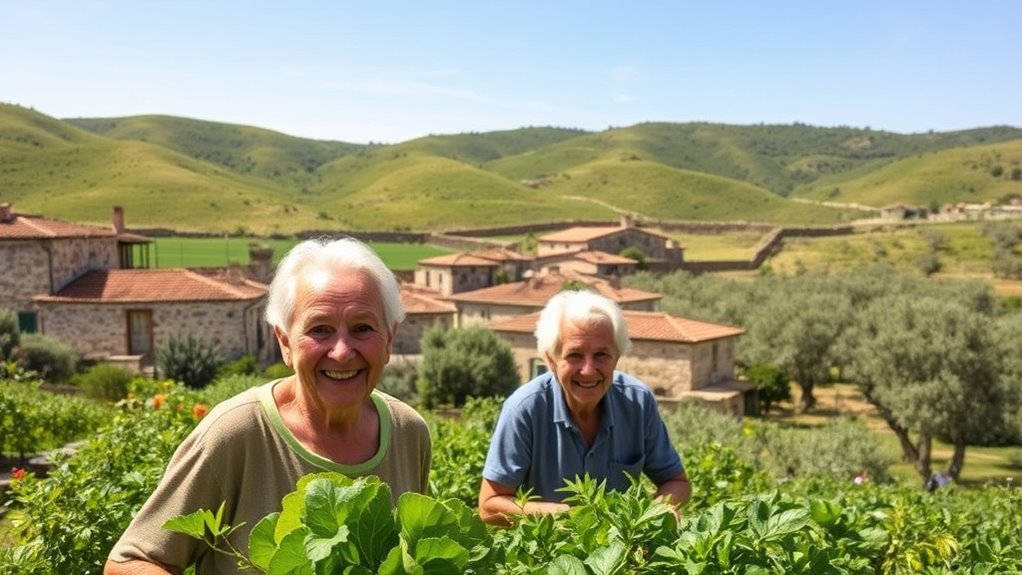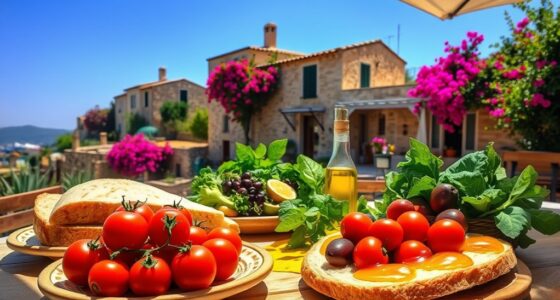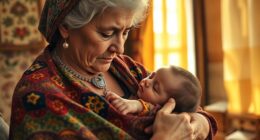The science behind Sardinian longevity shows that a mix of genetics, traditional diet, active rural lifestyles, and strong social bonds helps people live long, healthy lives. Unique gene variants, combined with a nutrient-rich diet of whole grains, legumes, and olive oil, support cellular health. Active farming and walking keep bodies strong, while community ties offer emotional resilience. If you want to discover how these factors work together to promote exceptional aging, this journey continues.
Key Takeaways
- Unique genetic markers and gene-environment interactions contribute to Sardinian longevity, though no single “longevity gene” has been identified.
- Traditional Mediterranean diet rich in whole grains, legumes, olive oil, and fermented dairy supports health and delays aging.
- Active rural lifestyles, including farming and shepherding, promote physical fitness and cardiovascular health.
- Strong social networks and community bonds enhance emotional well-being and resilience, reducing stress-related health issues.
- Environmental factors like low pollution and pristine natural surroundings help maintain health and prevent disease.
Unique Demographic Patterns and Concentrations of Centenarians
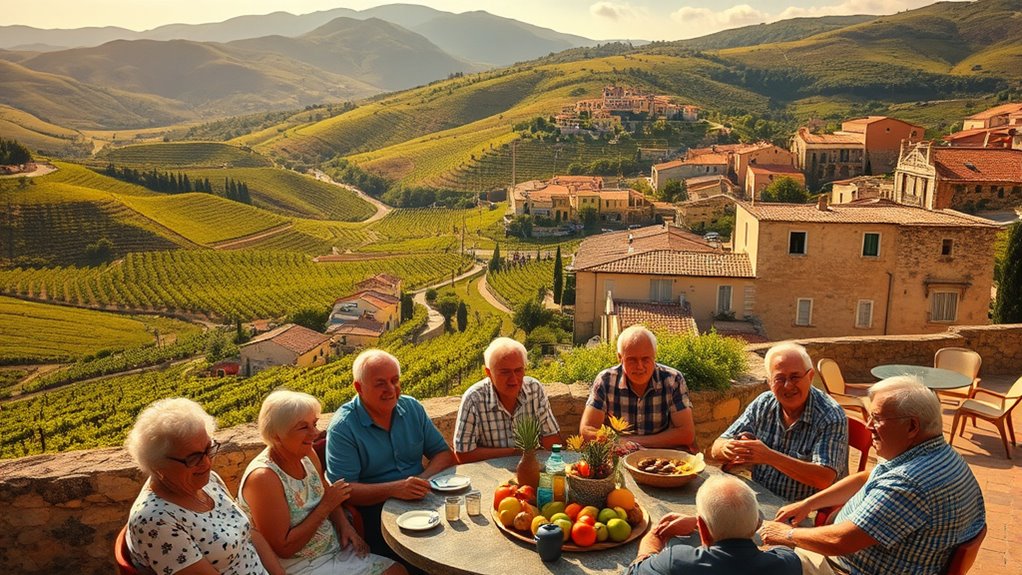
Sardinia’s Blue Zone stands out because of its remarkable concentration of centenarians, particularly in the mountainous provinces of Ogliastra and Nuoro. In these areas, certain municipalities like Villagrande Strisaili show an exceptionally high number of people living past 100. Instead of a uniform distribution, centenarians cluster in specific communities, resulting in about 33.6 centenarians per 100,000 residents—much higher than many other regions worldwide. Studies reveal these hotspots have more than double the Extreme Longevity Index of the rest of Sardinia. Fascinatingly, men in these areas sometimes outnumber women among the oldest old, contrasting global patterns. This demographic anomaly reflects lower mortality rates for elderly men and suggests that longevity traits are strongly localized within these communities. Additionally, research indicates that interpersonal relationships and social engagement play a significant role in promoting longevity in these populations.
The Role of Genetics in Sardinian Longevity
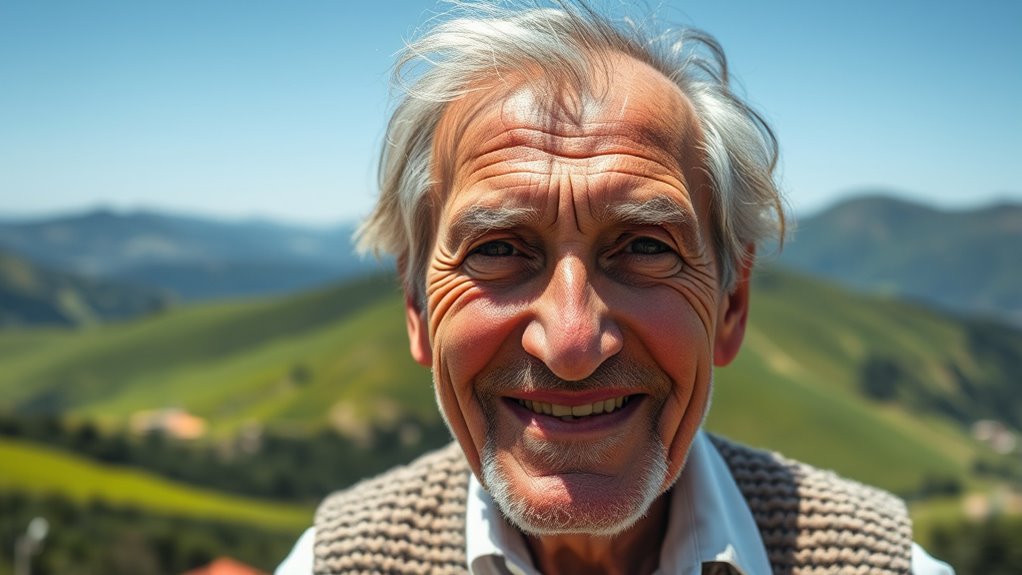
You might expect genetics to be the main driver behind Sardinia’s long life spans, but the evidence is mixed. While some genetic markers have been identified, their direct impact on longevity remains unclear due to complex gene-environment interactions. Overall, heritability seems less significant than lifestyle and environmental factors shaping Sardinian longevity. Recent studies suggest that non-genetic factors play a more prominent role in promoting exceptional aging in this population.
Genetic Markers Identified
- Specific gene variants like TAS2R38influence dietary habits.
- Haplogroup J enhances mitochondrial efficiency.
- Immune-related markers support resilience and tissue repair.
- Epigenetic modifications regulate inflammation and regeneration.
- Population studies leverage genetic homogeneity for clearer insights.
- Ongoing research aims to identify additional longevity-associated genetic factors that contribute to the Sardinian longevity phenomenon.
- Advances in genomic sequencing enable more precise identification of genetic markers, deepening our understanding of longevity traits.
Gene-Environment Interactions
Genetic factors alone don’t fully explain the remarkable longevity observed in Sardinian populations; instead, their genes interact dynamically with environmental influences to shape aging outcomes. Historical events like selective pressures from past hardships, including slavery, favored survival of the strongest, passing longevity-linked genes across generations. Geographic isolation and limited gene flow helped preserve rare genetic variants associated with longevity in specific regions like Ogliastra. Lifestyle factors, such as active pastoral work, traditional diets rich in healthy fats, and strong social bonds, influence gene expression and promote resilience. Additionally, Sardinia’s history of infectious diseases has shaped immune system adaptations that work synergistically with genetics. Genetic diversity within the population These gene-environment interactions create a complex and adaptive environment that supports exceptional longevity in Sardinian communities.
Inconclusive Heritability Evidence
While early studies suggested a strong genetic basis for Sardinian longevity, recent research paints a more complex picture. You find that genetic analysis shows Sardinians, especially in Ogliastra, have a unique genetic fingerprint, but no single “longevity gene” has been identified. The high prevalence of disease-related traits indicates a complicated genetic background. Whole genome sequencing reveals unique variants, yet they don’t conclusively link to longer life. You also learn that genetic contribution might be smaller than previously thought, with many small-effect genes involved. Additionally, male longevity patterns differ from global norms, suggesting genetic and lifestyle factors interact. Genetic studies have yet to pinpoint a definitive longevity marker, highlighting the multifaceted nature of aging. Furthermore, the interplay between genetic and environmental factors appears crucial in understanding Sardinian longevity. Unique genetic traits don’t directly cause longevity – Malaria-driven selection influenced gene frequencies – No definitive “longevity gene” identified – Genetic influence is likely polygenic – Non-genetic factors play a significant role
Environmental and Lifestyle Factors Supporting a Long Life
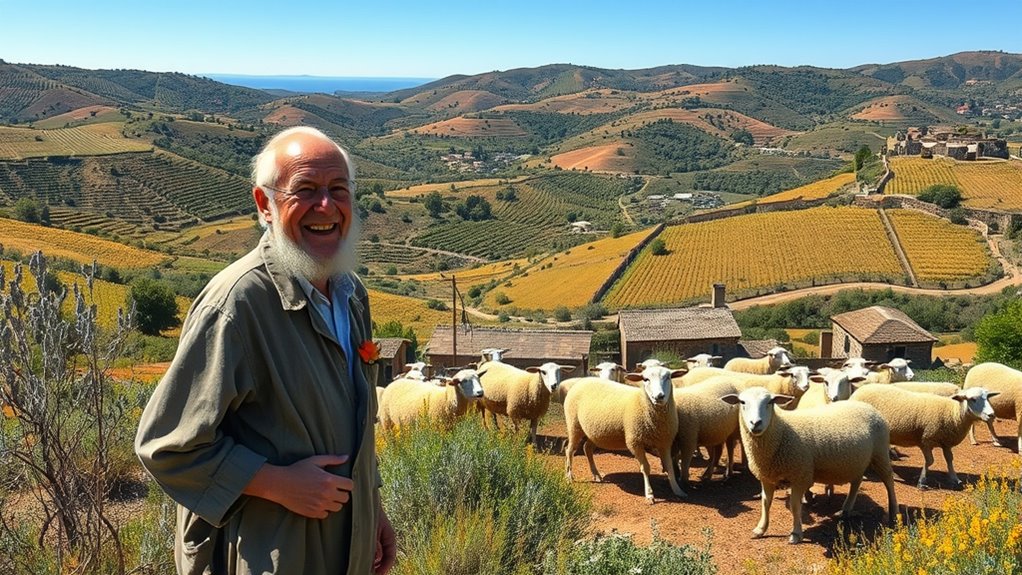
Your daily choices and environment play a vital role in Sardinians’ exceptional longevity. Their traditional diet, active rural lifestyle, and strong social bonds create a foundation for lasting health. Exploring how these factors work together can reveal the secrets behind their extended lifespans. Environmental and Lifestyle Factors Supporting a Long Life also include the low levels of pollution and pristine natural surroundings that help maintain health and prevent disease, further contributing to their remarkable longevity. Additionally, the soil quality in the region, rich in organic matter, supports the growth of fresh, nutrient-dense foods integral to their diet.
Traditional Diet and Nutrition
The traditional Sardinian diet plays a central role in supporting the islanders’ remarkable longevity by emphasizing nutrient-rich, minimally processed foods. You benefit from a primarily plant-based diet featuring whole grains like barley and wheat, along with legumes such as chickpeas and fava beans. Regular consumption of fermented sheep and goat dairy products like casu axedu supplies essential protein, especially for elders. Extra virgin olive oil provides healthy monounsaturated fats that promote heart health. Moderate red wine intake adds antioxidants like resveratrol, linked to reduced cardiovascular risk. This diet’s high nutrient density supports immune function and delays aging. The diet’s low intake of refined sugars and processed foods further reduces inflammation and oxidative stress, contributing to healthier aging. – Focus on local, seasonal foods for freshness and nutrients – Limited processed foods due to isolated, pastoral lifestyles – Balanced meat consumption, mainly salt-preserved and infrequent – Strong social bonds reinforce traditional eating patterns – Dietary stability preserves health benefits over generations. Additionally, the emphasis on seasonal, local foods ensures maximum nutrient retention and freshness, enhancing the diet’s health benefits.
Active Rural Lifestyle
An active rural lifestyle is a cornerstone of Sardinian longevity, as traditional farming, shepherding, and manual work in mountainous terrain naturally keep residents physically engaged. Walking and hiking on uneven landscapes provide excellent cardiovascular exercise, while daily chores strengthen muscles and endurance. This active routine continues into old age, supporting mobility and balance. The rural environment offers clean air, low pollution, and natural surroundings that boost respiratory health and vitamin D levels, enhancing psychological well-being. Limited exposure to urban stressors reduces inflammation and stress-related health issues. Rural settings also have lower levels of noise pollution, which can positively impact sleep and overall health. Community ties and shared activities foster social cohesion, further promoting mental health. The balance of moderate stress from physical work and the serenity of rural life builds resilience, helping residents enjoy healthier, longer lives. Additionally, the natural environment’s pollution levels play a significant role in reducing health risks associated with urban living.
Strong Social Networks
Strong social networks play a crucial role in supporting longevity among Sardinians by fostering emotional well-being and resilience. Living in multi-generational households, you benefit from continuous emotional support and companionship, which reduces stress and boosts mental health. Regular interactions with family encourage healthy behaviors like balanced diets and physical activity. Emotional support also lowers the risk of depression and helps maintain psychological stability into old age. Community engagement through festivals and local events strengthens social bonds and reduces loneliness. Strong ties with neighbors and friends create ongoing support that protects against chronic diseases. Sardinian elders maintain positive social connections, helping them adapt to social changes and stay psychologically healthy. These networks serve as vital buffers, promoting a longer, healthier life. Research has shown that people with robust social networks tend to live longer than isolated individuals, which further emphasizes the importance of social ties in longevity. Multi-generational households foster emotional bonds and healthy habits. Community events enhance social cohesion and mental well-being. Close social ties reduce loneliness and premature mortality. Maintaining social connections supports psychological resilience. Emotional support buffers stress, strengthening immune health. Additionally, a supportive community environment can facilitate access to resources and health services, further contributing to longevity.
Dietary Habits and Physical Activity as Longevity Resources
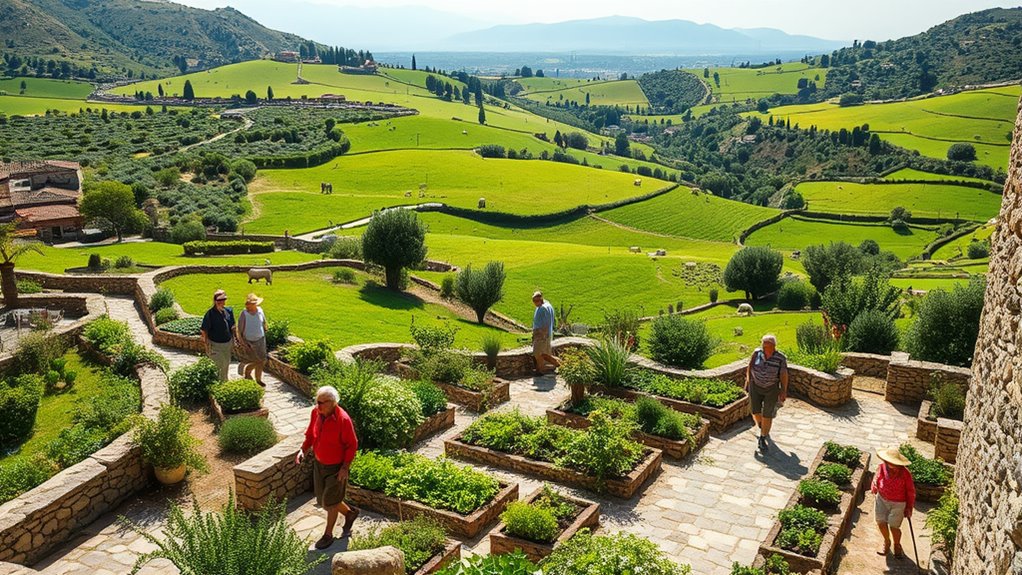
How do Sardinians achieve such remarkable longevity? Their diet plays a vital role. They consume plenty of whole grains, legumes, vegetables, and fruits, providing fiber, antioxidants, and vitamins. Extra virgin olive oil is their main fat, rich in healthy monounsaturated fats and polyphenols that fight inflammation. Moderate eating of fish supplies omega-3s for heart health, while red meat and processed sugars are limited, reducing chronic disease risks. Locally sourced, seasonal produce ensures nutrient density and minimal processing, and traditional preservation techniques keep processed foods low. Organic cultivation techniques and sustainable practices further enhance the quality of their food sources. Physical activity is embedded in daily life—shepherding and farming involve walking, lifting, and outdoor work, promoting cardiovascular health and muscle strength. Additionally, high rates of centenarians contribute to understanding the lifestyle’s effectiveness, as their long lifespans exemplify the success of these habits. Combined, these diet and activity habits create a sustainable, healthy lifestyle that supports longevity.
Social Structures and Cultural Practices That Promote Well-Being
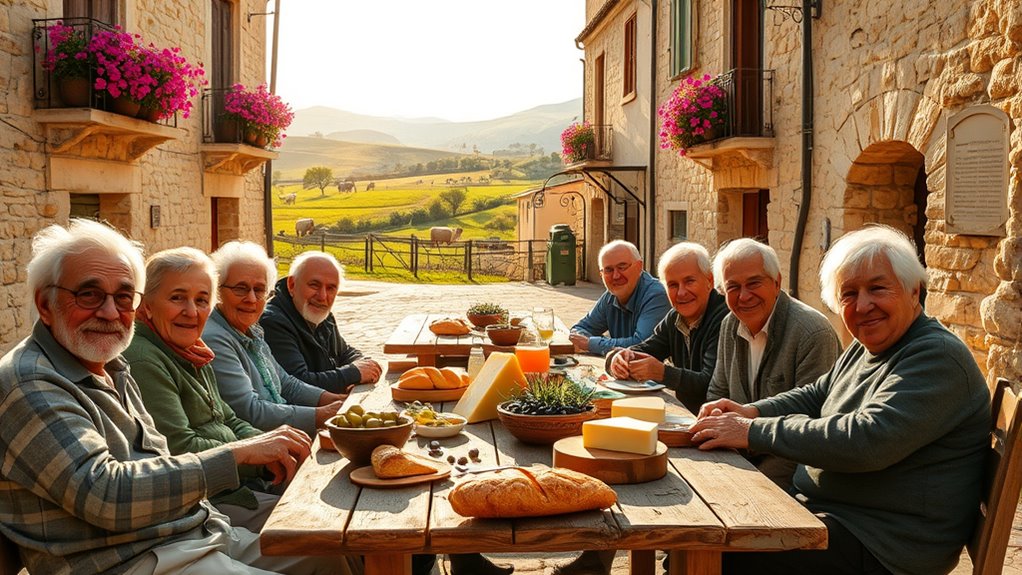
In Sardinia, social structures and cultural practices play a crucial role in promoting well-being and longevity. You benefit from strong family bonds, where multigenerational households foster daily interaction and shared responsibilities. Elders are respected for their wisdom, giving them a sense of purpose and mental resilience. Close proximity within families boosts social support, reducing stress and enhancing emotional health. Community cohesion is deeply rooted, with neighbors sharing meals and traditions that reinforce social bonds. This collective identity fosters resilience and psychological well-being. Additionally, gender roles influence health outcomes: men’s physical activities and social status promote longevity, while women’s roles can impose stress. Overall, social integration, active lifestyles, and cultural cohesion create a supportive environment that sustains long life in Sardinia. Incorporating social support systems can further enhance mental health and community resilience.
Mortality Trends and Disease Resistance in Elderly Sardinians
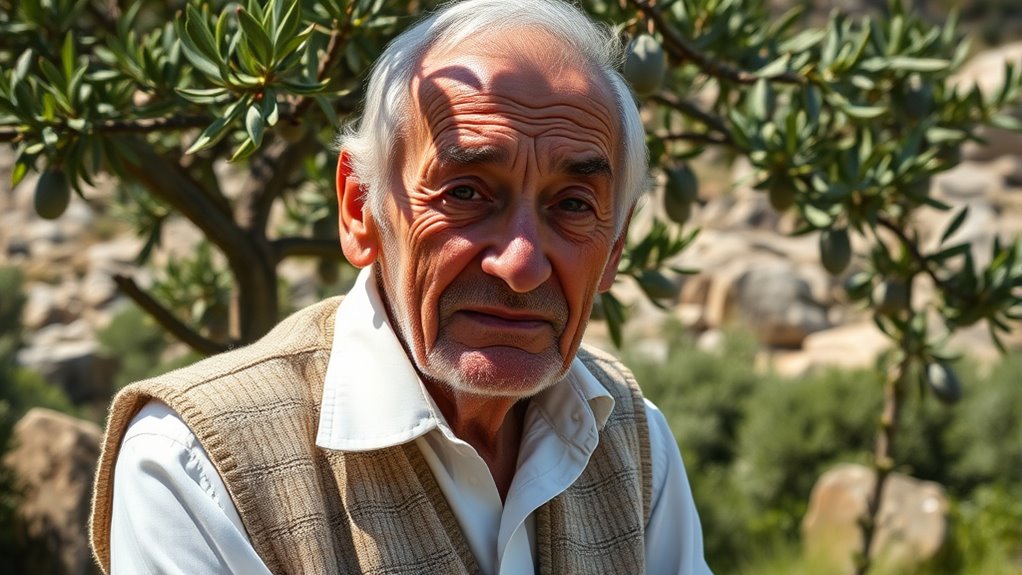
Sardinia’s elderly population exhibits unique mortality trends that contribute to its exceptional longevity. You’ll notice a high concentration of centenarians, especially men, surpassing other regions. The critical survival window between ages 80 and 100 heavily influences this longevity, with mortality rates remaining low during these years. Localized studies show consistent gender and age patterns, revealing longevity clusters within specific communities. Historically, Sardinians had higher life expectancies than mainland Romans, with fewer early childhood deaths and more deaths among older adults—indicating early factors supporting long life. Sardinian elders also demonstrate lower rates of chronic diseases like cardiovascular conditions and certain cancers. Their resistance to infectious and age-related illnesses, combined with preserved cognitive function and lower metabolic syndromes, underscores the region’s distinctive disease resilience. Recent archaeological findings further support the idea that longevity traits may have deep roots in Sardinian history.
The Impact of Rural Living and Low Pollution Levels
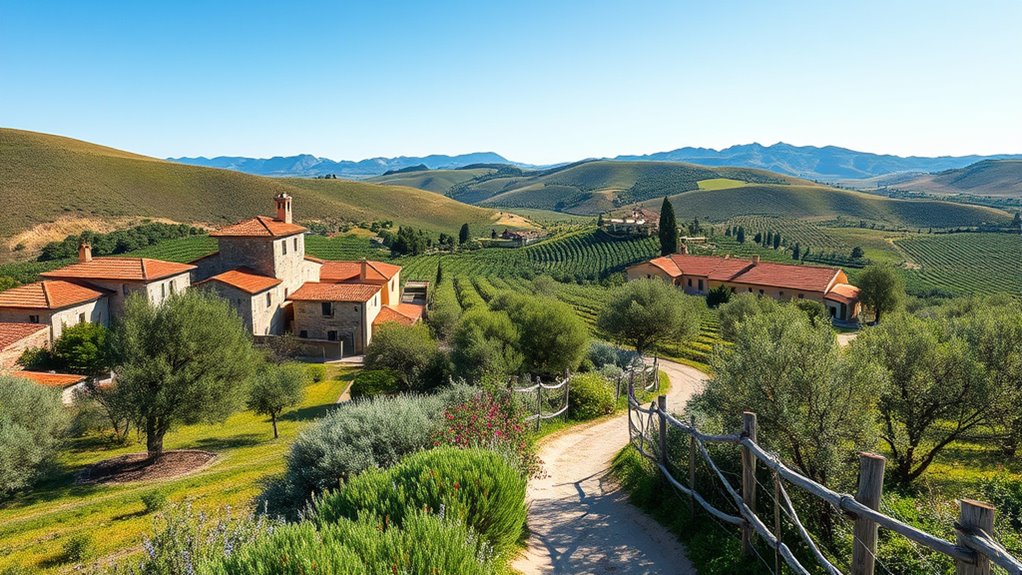
Rural living in Sardinia plays a significant role in supporting its residents’ exceptional longevity. Living in mountainous, isolated areas like Ogliastra and Nuoro helps preserve genetic traits linked to long life, such as the M26 haplotype. Engaging in traditional activities like farming, hunting, and fishing keeps you physically active, boosting health. The rural environment offers clean air and limited industrial pollution, reducing risks of respiratory and cardiovascular diseases. Sparse traffic and unpolluted natural resources, like mountain water and soil, further protect your health. This setting also minimizes exposure to harmful chemicals. Overall, the slow pace of rural life, strong community bonds, and healthy local diets create a lifestyle that promotes longevity.
Rural Sardinia’s isolated lifestyle and traditional activities foster longevity and overall health.
- Preservation of longevity-linked genes
- Physical activity from traditional work
- Low exposure to pollutants and chemicals
- Reduced urban stressors
- Strong social and community ties
Challenges in Research and Understanding Longevity Mechanisms

Researching the mechanisms behind Sardinian longevity presents numerous challenges, especially verifying the ages of centenarians and supercentenarians. Birth records in rural areas can be inconsistent, making it difficult to confirm ages reliably. Sardinia’s validated records help reduce errors, but data gaps remain. Longevity also involves complex factors like lifestyle, genetics, environment, and psychosocial elements, which are hard to isolate and measure accurately. Genetic studies face limitations, such as population isolation and limited genomic data from long-lived individuals, complicating interpretations. Additionally, psychosocial influences like resilience or community support are subjective and challenging to quantify. These hurdles hinder a clear understanding of longevity, requiring multidisciplinary approaches and standardized protocols to untangle the intricate web of contributing factors. Accurate age verification remains a critical step in ensuring the validity of longevity research findings.
Interplay of Genetics, Environment, and Lifestyle in Longevity
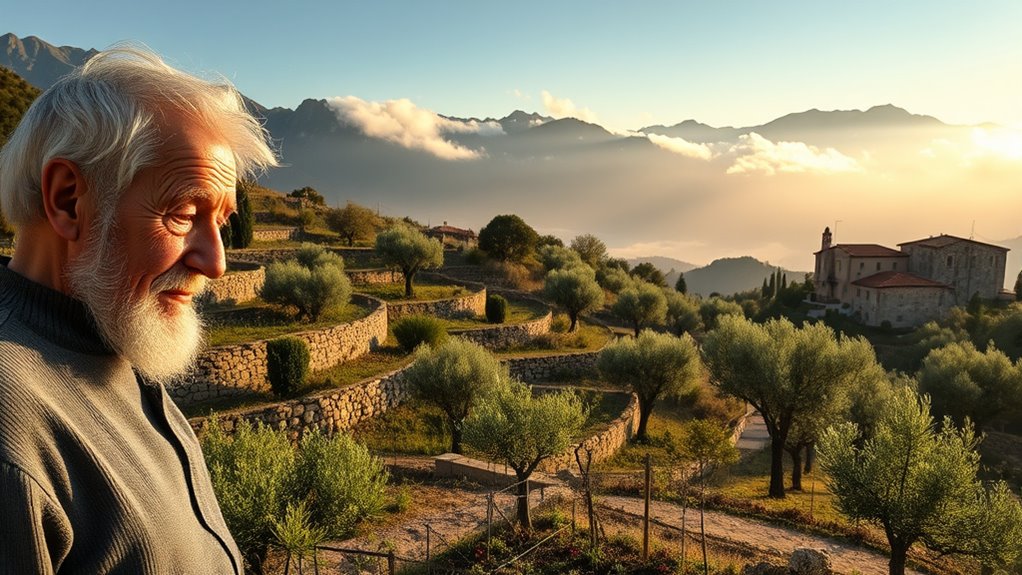
The longevity of Sardinians results from a complex interplay between their genetic makeup, environmental conditions, and lifestyle choices. Their isolated population and stable environment support healthy aging, while traditional diets rich in plant-based foods promote metabolic health. Physical activity from farming and pastoral work maintains cardiovascular resilience, and strong social bonds reduce stress and foster emotional wellbeing. Genetics also play a role, influencing mitochondrial efficiency and gene variants linked to dietary habits, though no single gene explains longevity fully. The interaction between these factors enhances cellular resilience and reduces age-related decline. This synergy is clearer in Sardinia’s isolated communities, where minimal genetic admixture and consistent lifestyles create a natural laboratory for studying longevity.
- Isolated population with minimal genetic admixture
- Mediterranean diet supporting cellular health
- Physical activity from traditional occupations
- Strong social and familial bonds
- Mitochondrial DNA variants influencing energy production
Frequently Asked Questions
What Specific Genetic Variants Are Most Strongly Linked to Sardinian Longevity?
You’re wondering which genetic variants are most strongly linked to Sardinian longevity. While no single gene has a definitive connection, some variants like the TAS2R38 gene, affecting taste perception, appear more frequently in centenarians. Mitochondrial haplogroup J might improve cell energy, and immune system-related polymorphisms could help delay aging. However, overall, longevity results from complex gene interactions combined with environmental factors, not just isolated genetic variants.
How Do Sardinian Social and Cultural Practices Directly Influence Aging and Health?
You’ll find that Sardinian social and cultural practices markedly boost your health and aging. With tight-knit families and frequent community events, your sense of belonging and emotional support increase, which can boost lifespan by up to 50%. Engaging in daily activities like farming and social gatherings keeps you physically active and mentally resilient. Cultural traditions and purposeful living foster positivity, helping you age healthier and happier through strong community ties and meaningful routines.
Are Environmental Pollutants in Sardinia’s Rural Areas Significantly Lower Than Elsewhere?
You might wonder if Sardinia’s rural areas have fewer environmental pollutants than other regions. The answer is yes; rural Sardinia generally experiences lower pollution levels because it lacks heavy industry and urban congestion. You’ll find less contamination from heavy metals and pollutants, mainly due to limited industrial activity. This cleaner environment, combined with traditional lifestyles, likely contributes to the island’s health advantages, making rural Sardinia relatively less polluted overall.
What Role Does Traditional Diet Play Compared to Genetics in Promoting Longevity?
Think of your health as a garden, where your choices and roots intertwine. Your traditional Sardinian diet acts like nourishing rain, enriching your soil and fostering longevity more than genetics alone. While your DNA sets the stage, it’s your eating habits—rich in olive oil, vegetables, and legumes—that truly cultivate a long, vibrant life. Embracing these foods helps you bloom, proving lifestyle holds the key to enduring vigor.
How Do Lifestyle Factors Interact With Genetics to Extend Lifespan in Sardinia?
You see, your lifestyle factors like regular physical activity and a balanced diet work hand-in-hand with your genetics to boost longevity in Sardinia. When you stay active through traditional occupations and follow dietary habits rich in antioxidants and healthy fats, it supports your body’s natural resilience. These behaviors amplify genetic advantages, such as mitochondrial efficiency, helping you stay healthier longer. Together, your genes and lifestyle create a powerful synergy for extended lifespan.
Conclusion
So, if you fancy living to a hundred while munching on local cheese and enjoying carefree village life, Sardinia’s secret isn’t rocket science—it’s just good old-fashioned luck, a dash of genetics, and a sprinkle of unspoiled environment. Maybe the real miracle is that we’ve overlooked simple pleasures and healthy living, instead chasing high-tech cures. Perhaps, in the end, longevity’s less about science and more about knowing how to enjoy life’s slower, tastier moments.
